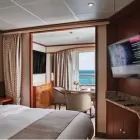- Ship
- 1 Breakfast, 1 Lunch, 1 Dinner
The calypso rhythms of steel pans are never far away, as you walk the streets of Trinidad and Tobago's capital, one of the largest cities in the region. Overlooking the Gulf of Paria, between the mountains of the Northern Range and the Caribbean Sea, Port of Spain is home to a famous, flamboyant carnival - and the excitement is palpable as it approaches, with spontaneous street parties spilling out. Whenever you visit, and whatever the excuse, there’s always a fete - a party - happening somewhere. Queen's Park Savannah is a lush green urban sanctuary, while Brian Lara Promenade is a striking tribute to Trinidad’s revered cricketing genius. Scattered with artworks, it's the perfect spot for a little liming – the local term for hanging out and taking it easy.
The waterfront is a lively area of bars and restaurants, and the perfect place to soak in some Caribbean sea air, with the waves splashing close by and fountains spurting. Just to the north of the urban sprawl is the revitalising Chaguaramas National Park. A wild place of shooting bamboo, scampering howler monkeys, and delightful coastal walks. Elsewhere, venture through coffee plantations and wildlife sanctuaries to discover endemic, colourful flora and fauna. As you'd expect from this Caribbean capital, it's a journey for the tastebuds, and the food here is fiery spicy and delicious. Try doubles for breakfast, a curried chickpea flatbread sandwich, before tearing into jerk fish later. You’re certain to come across the ever-present green seasoning sauce, flavoured with fresh coriander, during your explorations.

























